Kraussiana, which also goes by various other names such as Krauss’ Spikemoss (Clubmoss), African Clubmoss & Mat Spike Moss, is well suited as a dense ground cover in terrariums.
Keeping it in a terrarium is actually the best way to ensure that your Clubmoss (just another name for the kraussiana) enjoys high levels of humidity; an absolute must when cultivating this Selaginella species.
Selaginella kraussiana Care
Selaginella kraussiana needs well-draining soil rich in humus and full shade away from direct sunlight. Keep the soil constantly moist but not soggy using rainwater or distilled water. Provide a temperature between 65-75°F (18-24°C) and high humidity of >70%. Fertilize once a month during the growing season using a balanced fertilizer at 1/2 strength.
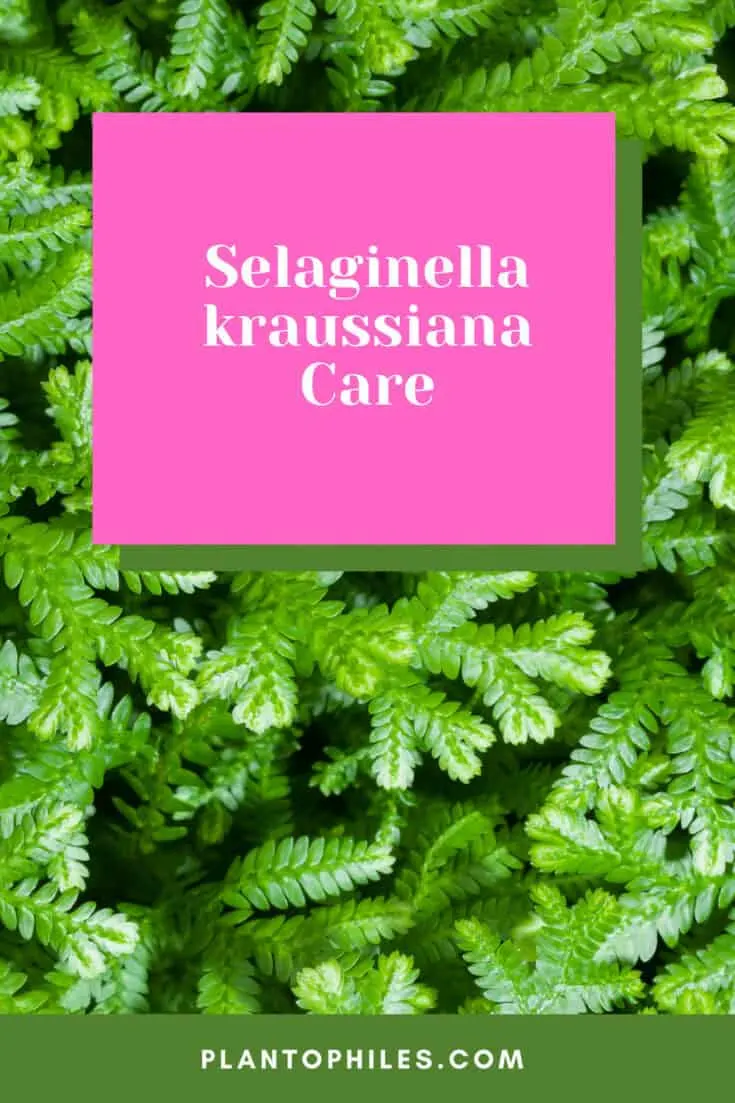
Selaginella kraussiana Care
Table of Contents
Selaginella kraussiana Care Guide
SOIL
Selaginella kraussiana feels most comfortable in well-draining soils.
As far as soil pH goes, aim for either neutral or acidic soil. A soil pH of around 6 yields good results.
Humus-rich soil is recommended.
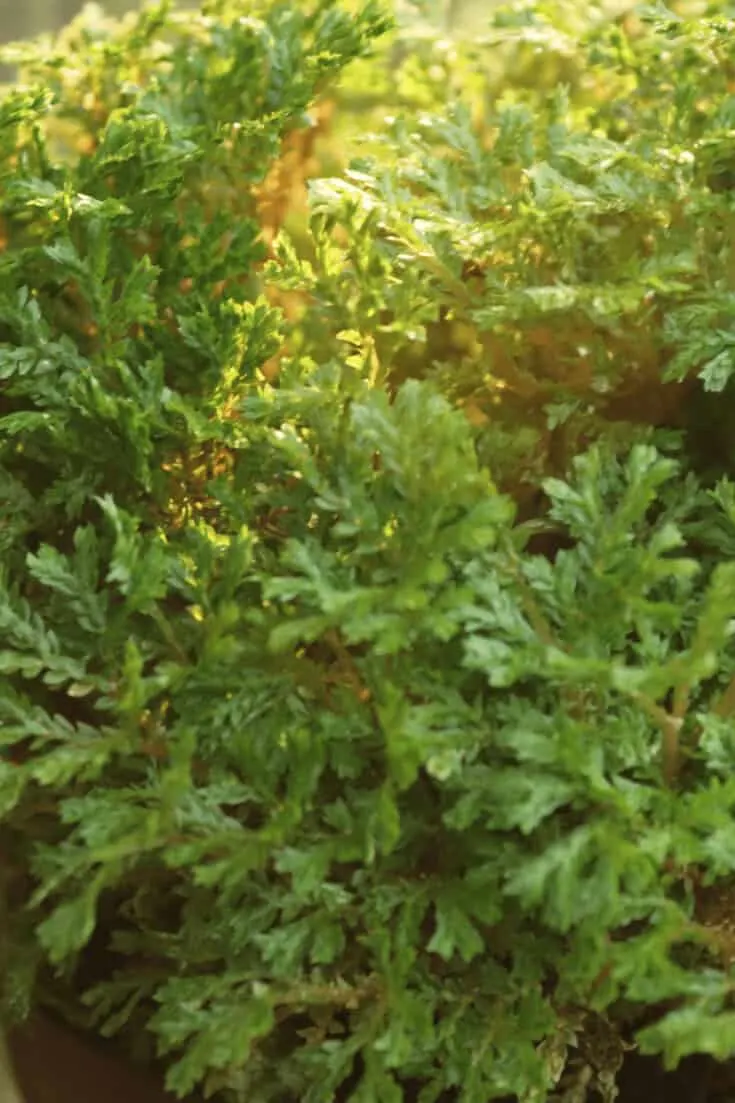
Selaginella kraussiana needs constantly moist soil
LIGHT
Selaginella kraussiana likes to sit in full shade.
While Krauss’ Spikemoss does well in low light, brighter light levels (semy-shady) are also tolerated by Krauss’ Spikemoss.
The general rule of thumb is: The lighter the plant gets, the brighter and greener the coloration of Selaginella’s leaves will become.
In any case, make sure to keep kraussiana out of direct sunlight. Direct sunlight will hurt your plant and scorch its leaves.
WATERING
When caring for Selaginella kraussiana, it is best to keep the compost moist, but not soggy. Never let the soil dry up completely.
Also, don’t use cold water for watering and preferably use soft water rather than hard water.
Kraussiana is not a fan of lime, so use lime-free water whenever possible.
Rainwater and distilled water are ideal.
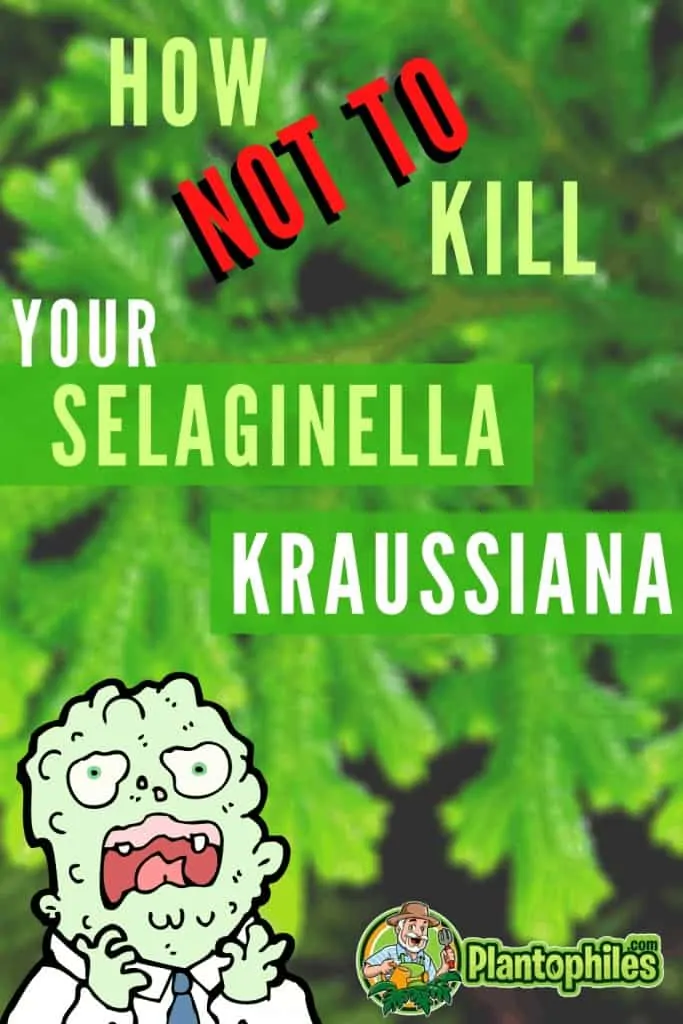
Selaginella kraussiana Care
TEMPERATURE
Average room temperatures 65 to 75 degrees Fahrenheit (that is 18 to 24 degrees Celsius), fare well with Selaginella kraussiana.
The African Clubmoss does not like draughts and fluctuations in temperature should also be kept to a minimum.
Colder temperatures are also tolerated by kraussiana, however, cultivation in zones prone to frost need to be avoided.
HUMIDITY
Selaginella kraussiana requires high humidity of 70% or more to thrive.
Humidity is the key factor when cultivating kraussiana. It requires very high humidity.
If you are not able to provide kraussiana with the required humidity, things will definitely not turn out well for your leafy friend.
Don’t expect your plant to last longer than a week or two if the humidity is too low.
If you don’t cultivate your Krauss’ Spikemoss in a terrarium, your best bet will be to place it in the room that provides it with the highest humidity.
This is usually the bathroom. But that alone will most certainly not be enough to keep your African clubmoss alive.
Further, increase the humidity by placing your Krauss’ Spikemoss on a humidity tray.
Another common “humidity hack” is to actually group your kraussiana between other plants. This will also help a lot in maintaining high levels of humidity.
Regularly misting the plant is also recommended, however, the impact that this will have on your plant, won’t be dramatic.
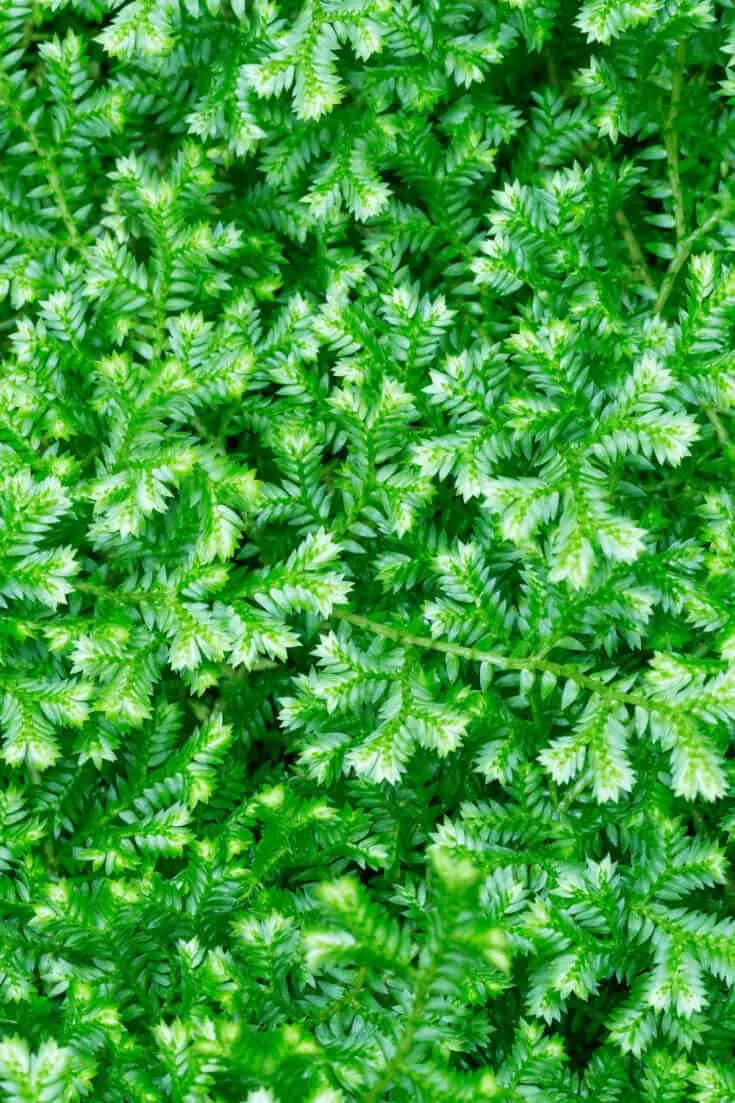
Selaginella kraussiana needy very high humidity of 70% or more
FERTILIZER
Feed your Selaginella kraussiana once a month starting from spring through fall. Use a balanced liquid fertilizer diluted to half the recommended strength.
And don’t forget: When it comes to fertilizing houseplants, less is often more.
Underfeeding is often not problematic while giving too much fertilizer may kill your kraussiana.
PROPAGATION
Selaginella kraussiana can be propagated through cuttings.
This also holds true for Selaginella martensii. Propagating Clubmoss that way will only work if you can provide the plants with very high humidity.
Kraussiana, as well as Selaginella apoda, can also be propagated through division (rhizome division in spring).
Propagating African Clubmoss that way is very easy.
If you do indeed enjoy propagating houseplants, we do have an interesting article for you that will tell you about the 12 easiest houseplants to propagate. Why not give it a go?
GROWTH
As typical for Selaginella, Selaginella kraussiana hardly grows in height with an ultimate height of about 4 inches (10cm) but spreads a lot due to its mat-forming habit.
It is, therefore, very well suited as a ground cover in terrariums.
POTTING
The best way to keep Selaginella kraussiana is not exactly in a pot as it is a terrarium kind of plant.
If you happen to have a terrarium, better place it in there. Your Clubmoss will love the constant high humidity that it can get in that kind of environment!
Instead of cultivating kraussiana in a terrarium, a bottled garden could also be a good choice for your Clubmoss, as this will, as well, ensure high humidity levels.
If you are unfamiliar with the term bottle garden, this simply means that you are going to cultivate your plant inside a specific glass container or even a plastic bottle.
In a few simple steps, you can easily create your own bottle garden.
More often than not, repotting is not even a concern with Krauss’ Spikemoss, as these plants often don’t last long enough to be transplanted into a new pot.
Krauss’ Spikemoss propagation techniques
Selaginella kraussiana can be propagated through plant division and through stem cuttings.
To divide your kraussiana, follow these simple steps:
- Carefully pull the whole plant out of the planter.
- Depending on the size of the plant, divide it into two or more sections.
- Plant each section in a new pot with new potting soil. Use well-draining, humus-rich soil.
If you would like to propagate your Selaginalle through stem cuttings, this is how you do it:
- Search for a healthy, mature stem on your plant
- Use sharp, sterile scissors and make a clean cut
- Take a new pot, use a fresh potting mix and plant your cutting directly in there
And what about propagating kraussiana through seeds?
Well, that is impossible, for the simple reason that this kind of plant (spore plant) does not produce any seeds at all.
But it produces spores, so what about propagating it through spores?
Spore propagation is how this plant multiplies itself in nature.
However, propagating through spores is a very slow-going process and is simply not practical for the average houseplant enthusiast.
Therefore, for fast results (a couple of weeks), you should stick to propagating your African Clubmoss through stem cuttings or multiply it through plant division.
Krauss’ Spikemoss: Display tips
As discussed earlier on, the kraussiana, an excellent ground cover, makes for a great terrarium plant.
The cultivar Krauss’ Spikemoss “Aurea” with its bright color is exceptionally well suited for that purpose.
Another Selaginellas that is used in terrariums is the dark green Selaginella moellendorffii, which also looks great when coupled with a bonsai.
That said, Krauss’ Spikemoss also looks great in hanging baskets.
If you have a general liking for houseplants in hanging baskets, you might also like Heartleaf Philodendron, Pothos or the String of Pearls.
Krauss’ Spikemoss: The perfect plant ground cover for your terrarium
As mentioned earlier in this article, Selaginella does very well in terrariums.
Not only is it very suitable as a beautiful ground cover, but also the high humidity level that terrariums can provide is ideal for the cultivation of Krauss’ Spikemoss.
That said, you could use this Selaginalla species as a ground cover for your
Selaginella disasters: Pests
Krauss’ Spikemoss is generally pest & disease-free. One thing you need to look out for when caring for Krauss’ Spikemoss is Crown Rot, though.
Visible signs of a struggling Selaginella plant
TELLTALE SIGN #1: Browned leaves
Browned leaves on Krauss’ Spikemoss are usually a sign of dryness. It could be that the soil is too dry or the humidity is too low, both of which could have a dramatic effect on your plant.
TELLTALE SIGN #2: Scorched leaves
If your kraussiana displays scorched leaves, it receives too much sunlight. Keep your plant out of direct sunlight!
TELLTALE SIGN #3: Crispy leaves
Crispy leaves on Selaginellas are usually a sign your plant does not get enough water. To solve the problem, water more regularly (or more thoroughly).
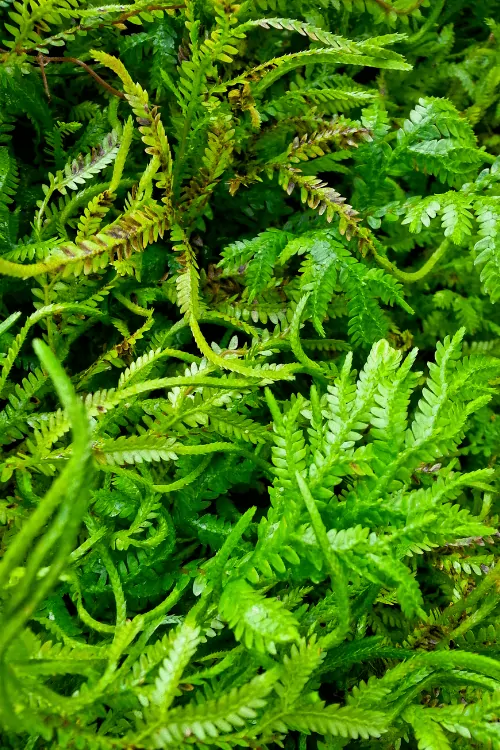
Kraussiana, aka Krauss’ spikemoss, is native to the Azores (Portugal), Canary Islands, and Africa. It is one of the very few Selaginella species that is actually cultivated as an indoor houseplant.
FIVE STEPS TO A HEALTHY Plant
- High humidity is the single most important factor when caring for Krauss’ Spikemoss.
- If you want to keep kraussiana longer than a couple of weeks, cultivating it in a terrarium is your best bet.
- Krauss’ Spikemoss does not like lime at all. Neither the water nor the substrate should contain (a lot of) lime.
- Keep your Selaginella evenly moist.
- A semi-shady to shady spot is where you should keep this Selaginella species.
Is Krauss’ Spikemoss care difficult?
Krauss’ Spikemoss care is not difficult per se, however, it is very specific.
Rule number one to take into account when caring for this Spike moss is to keep the humidity high at all times.
If you are not living in a tropical region, this plant will only have chances to survive if you do indeed increase the humidity. Everything above 70% humidity will do.
The easiest way to maintain a high level of humidity for your Krauss’ Spikemoss is to simply cultivate it in a terrarium.
If that is not possible, then you could keep it in a bottle garden.
Don’t forget to regularly spray the leaves, as this will also help to keep the humidity high.
Looking for yet another exciting Selaginella plant?
Not many of the about 700 species of Selaginella, belonging to the family of Sellaginellaceae, are cultivated as indoor plants.
One of the chosen few is the so-called Resurrection plant (Selaginella lepidophylla).
You might wonder, why it is called that way. There’s certainly a reason for it!
You can find the solution to this mystery in our in-depth Resurrection Plant Care article.
Frequently Asked Questions About Krauss’ Spikemoss
Does Selaginella kraussiana have any nicknames?
Krauss’ Spikemoss is also known as African Clubmoss, Mat Spike Moss & Krauss’ Spikemoss & Trailing Spikemoss.
How long does Selaginella kraussiana survive?
Selaginella plants are very difficult to please, mainly due to the fact that they are in need of high humidity to survive. If you don’t meet the required humidity levels, your Krauss’ Spikemoss is unlikely to get older than a couple of weeks.
Does Selaginella kraussiana flower?
Krauss’ Spikemoss is a spore plant and spore plants don’t flower.
Is Selaginella kraussiana poisonous to cats?
Krauss’ Spikemossis non-toxic to cats.
Is Selaginella kraussiana poisonous to dogs?
Krauss’ Spikemoss is non-toxic to dogs.
How not to kill my Selaginella kraussiana?
Humidity. The secret to keep your Krauss’ Spikemoss alive is to provide it with enough humidity. But how much is enough? A humidity of about 70% should do. You could easily go higher than that, though. Therefore, cultivating your Krauss’ Spikemoss in a terrarium (or a greenhouse) is usually your best bet.
Where can you buy a Selaginella kraussiana plant?
You can find Krauss’ Spikemoss on Amazon.
Can you keep Selaginella kraussiana in a terrarium?
Absolutely. This is actually the best way to cultivate Krauss’ Spikemoss, as it makes it much easier to reach the required humidity that Selaginella kraussiana is dependent on.
What’s a Frosty Fern?
Frosty Fern is actually a variegated species of Krauss’ Spikemoss. The correct name of the cultivar Frosty Fern would be Selaginella kraussiana variegatus.
Is Selaginella kraussiana a fern?
The Selaginella family comprises about 700 species, none of which are ferns. But at first glance, they do look a lot like ferns and in some cases also like mosses.
Is Selaginella kraussiana a moss?
Selaginella kraussiana is not a moss. And, surprisingly, it is also not a fern. So what is it then? Well, it is a spike moss. And no, a Spike moss is not a moss (sounds strange, but that’s just the way it is).
What are some interesting cultivars of Selaginella kraussiana?
There’s Krauss’ Spikemoss “Aurea” that comes in a yellow color, there’s Krauss’ Spikemoss“Variegata” that is yellow-greenish and there’s also the soft, cushion-forming cultivar “Brownii”. Another popular variety of Krauss’ Spikemoss is the cultivar “Frosty Fern” which features very pretty leaves with creamy white fronds.
In which hardiness zones can Selaginella kraussiana be grown successfully?
Selaginella kraussiana grows in USDA hardiness zones 6 to 10.

Daniel has been a plant enthusiast for over 20 years. He owns hundreds of houseplants and prepares for the chili growing seasons yearly with great anticipation. His favorite plants are plant species in the Araceae family, such as Monstera, Philodendron, and Anthurium. He also loves gardening and is growing hot peppers, tomatoes, and many more vegetables.


